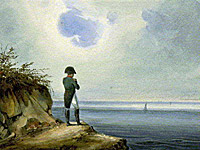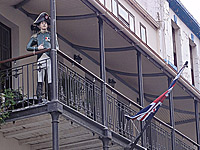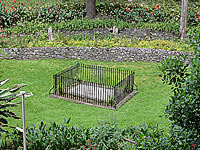| FROM THE LOG #90
The Island of St. Helena
|
 The hard way to earn a beer |
| Click on any photo or map for a blow up. (Remember to close it also, otherwise it will be open behind next window) |
Located in the South Atlantic Ocean, more than 2,000 kilometres from the nearest major landmass, Saint Helena is one of the most remote places in the world. The nearest port on any continent is Namibe in Angola, the nearest international airport is in Angola's Capital Luanda. Together with two other isolated islands in the Southern Atlantic (Ascension about 1,300 kilometres to the northwest and Tristan da Cunha 2,430 kilometres to the south) St Helena forms a British Overseas Territory called, not surprisingly, St Helena, Ascension and Tristan da Cunha.
There is no airport on the island and no regular connections by ship except for the supply ship RMS St Helena (RMS stands for Royal Mail Ship), which visits with about two weeks intervalls. Saint Helena was first settled by the English in the mid-1600s, and the island presently has a population of about 4,250 inhabitants, mainly descended from settlers and soldiers from Britain and slaves from Africa, India and Madagascar. There is no mobile phone network on the island.
 |
 |
 |
| Approaching St Helena |
We arrived in James Bay in front of the main settlement Jamestown on the 7th of February 2013; 9 days and two hours after our departure from Walvis Bay in Namibia. The 1,220 nautical mile-passage was reasonably easy, but not the milk and honey run promised by several accounts of previous cruisers. The first days, and nights in particular, were very chilly, due to the cold Benguela current and the cloudy skies. The mostly light winds were usually dead astern from SE and, in combination with a 3-4 metre swell on the port quarter, generating a violent sideways rolling movement. It is difficult to trim the sails in these conditions as the head sail tends to get into the lee of the mainsail even if you have the headsail poled out 'wing on wing' to the opposite side of the main boom.
 |
 |
 |
| The woollies are out again (although we technically are in the Tropics) |
Glass-spiced sausage soup, and we ate it all! |
Sunrise (unusual on this passage) |
However, by each day the temperature rose a little and we started to get some sunshine in the afternoons, which helped to keep up the spirit although we had problems with our alternators again. On a long trip, the ability to charge batteries is essential as the autopilots need electricity, and as the skies were mosty over cast, rendering the solar panels useless in practice, we depended completely on the alternators. Somehow I managed to temporarily keep at least one alternator charging all the way. If I can't get this problem, which has been bothering us all season (despite being 'repaired' in almost every port) solved at St Helena it will probably stay with us all the way to the Caribbean.
The only accident on this passage was the collaps of the glass made lid of our soup kettle (see photo above). But we ate the soup!
 |
| A panorama of the anchorage in James Bay. The visitors' mooring field is on the left. Local boats and the town dock are on the right. |
Traditionally, anchoring in James Bay has been difficult due to the deep water and suspect holding. Recently the situation has dramatically improved for visiting yachts as two dozen strong moorings have been built by the government. This improvement followed the total loss of a yacht when a mooring failed and the government had to pay substantial compensations.
Landing a dinqhy at the slippery quay in the constant surge is still difficult and very few yachts bother to even launch their dingies. Instead we use the 'ferry service' operated by Rich in the mornings and Steve in the afternoon. They do their round around the mooring field every two hours, picking up and bringing back cruisers from/to their yacht (photos below).
 |
 |
 |
| Cruisers returning home from a shore trip | The crews of Cat's Paw 4, Tagish, Valentina and Scorpio going ashore by 'ferry' |
Ferryman Rich |
During our stay it appeared that Finland is one of the great seafaring nations together with Canada, as there were three yachts from both of these countries in the port. Other yachts came from USA (2), Brazil, Germany, France, Norway and UK (Guernsey). Last time we were part of a Finnish invasion was in 2005 at Puerto Lucia in Ecuador.
 |
This is not a zoom-in of a satellite image of Google Earth, but it is Jamestown viewed from the top of Jacob's Ladder. |
 |
 |
 |
| Jacob's Ladder has 699 steps | Scorpio's skipper is almost at the top | Scorpio and Elaine |
 |
| The mooring field viewed from Ladder Hill. Scorpio is fourth from the right. |
Discovered by the Portugese in the early 1500s, St Helena became a Dutch then British possession (initially under the East India Company). The island was a strategically important port of call during the British Empitre until the opening of the Suez Canal and the advent of the steamships.
St Helena's remoteness has made it an ideal place for imprisoning dangerous people, Napoleon being the most famous. He spent his last 6 years here from 1815 to 1821 and probably died of boredom (being accustomed to an other way of life).
 |
 |
 |
| Napoleon is very much present today | ||
 |
 |
 |
| Longwood House was Napoleon's home for 6 years |
Napoleon's tomb (but his coffin is in Paris) | Briar's Pavillion where Napoleon spent his first 7 weeks on the island |
Joshua Slocum visited St Helena for 10 days in 1898. He was extended hospitality from the governor and presented two lectures before taking off on the final leg of his solo circumnavigation. Other famous navigators who have stopped here are Francis Drake, Horatio Nelson, James Cook and Charles Darwin.
The main way to reach St Helena is aboard the RMS St Helena, one of the last Royal Mail ships plying the oceans. The RMS, as the ship is known among the Saints, as the islanders call themselves, is the islands lifeline, bringing cargo, residents and visitors - a few tourists among them. It operates between Cape Town, Ascension Island and St Helena. It is a big day when the RMS arrives and people gather in the harbour just to watch the show when the cargo is unloaded.
The largest category of visitors to St Helena is made up of the crews of cruising yachts, like ourselves, on the way from South Africa to the Americas. Around 100 to 200 yachts per year stop for a couple of days or a week bringing up to 500 visitors.
 |
 |
 |
| The supply ship RMS St Helena has arrived | ||
 |
 |
 |
| RMS anchored in James Bay | The RMS arrives at 14 days intervalls | Hard Hat Area |
 |
 |
 |
| The Consulate Hotel | An atmosphere of days gone by | Flood gate |
 |
 |
 |
| Risto and Helinä on s/y Valentina | Waiting for 'ferry service' with the crew of s/y Elaine |
At the world's most remote destillery |
 |
 |
 |
On Saturday, February 16 we plan to continue on our voyage. Our next stop will probably be at either Ascension Island, 700 nm away, or the Brazilian island of Fernando de Noronha, at a distance of 1,800 nm.
The date of our next update will depend on what kind of internet facilities we find at the next stops.
[PREVIOUS] |
[NEXT] |